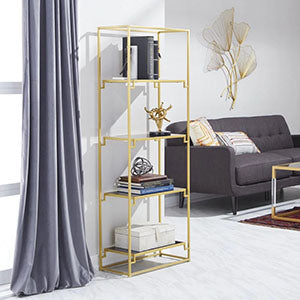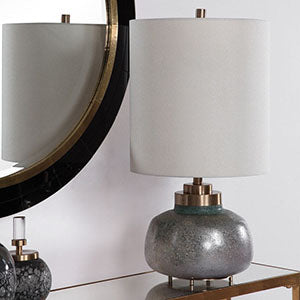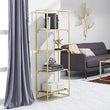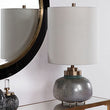Lighting
Home Office Lighting: Tips and Tricks to Brighten Your Workspace
If you work from home, the lighting in your office matters as much as fast WiFi, a powerful computer, a clutter-free desk, and a supportive chair. The lighting choices you make can impact your productivity, your appearance during video conference calls, and your excitement to start the day. Read on for home office lighting tips and tricks to make your workspace bright, welcoming, and stylish to boot.

The lighting choices you make can impact your productivity, your appearance during video conference calls, and your excitement to start the day.
How to Light a Home Office
Lighting an office is similar to lighting a kitchen—you will need task, ambient, and accent light sources to create the appropriate layers of illumination. Start by building an office lighting plan:
Bring in natural light. Sunshine enhances concentration, decision-making, and productivity. For offices with windows, the trick is achieving a warm, sunny space while also avoiding glare. To do this, set up your workstation facing the window or right next to it (facing the wall) so the natural light doesn't shine directly on your computer screen. Utilize blinds and shades to control and soften the light so it's not too intense.
Trick: If your desk is by a window, try to situate it so you are facing either north or south and not east or west to avoid shadows cast by the rising and setting sun.
Audit your artificial light. To achieve balanced light layers, you'll need multiple light fixtures throughout your office. This is even more important if you're lighting a space with no windows or limited natural light. Create a project worksheet and record the location of each light fixture in your office. Include details such as:
- Whether a light has a shade
- Shade color and opacity
- Types of bulbs (incandescent, LED, halogen) and their color temperatures
- The area the light illuminates
- What the light is used for—performing tasks, general ambient light, or accent lighting)
- How long you use each light on an average day
Define your workspace. Your natural light source is really the only lighting element that dictates your workspace. Otherwise, you can decide where you want to do your work and adjust your lighting setup as needed. Use your artificial light audit to see which light sources are already in place, and which fixtures you need to add for layered lighting.
For example: Consider a desk showcasing an LED lamp giving off a nice warm white glow with a solid color temperature of 3000K, but no overhead fixture to produce ambient light. You'll want to add a ceiling light or recessed lighting—ideally not directly above your workspace—to avoid uneven room lighting and potential eye strain.

Choose bulbs in the 2700K to 3000K color temperature range for task lighting.
What's the Best Lighting for Computer Work?
A computer is a major consideration for a home office lighting plan. It casts its own light which, if not positioned or balanced correctly by other light sources, can cause eye strain. These are essential strategies for lighting around a computer:
Position task lighting to the side of the computer. You don't want your lamp casting glare onto your screen. Rather, the goal of office lamps is to supply indirect light around your computer area, as well as task lighting for hard copy work. Opt for a vintage desk lamp or a contemporary floor lamp with a suspended light diffuser. Choose bulbs in the 2700K to 3000K color temperature range for task lighting.
Install a ceiling fixture for indirect ambient light. This provides lighting balance throughout the workspace. Consider elegant semi-flush mount ceiling fixtures with frosted globes or stylish pendant lights installed behind your chair. Shoot for bulbs with color temperatures between 3500K to 5500K. This provides brightness that's conducive to wakefulness and productivity.
Home Office Ceiling Light Ideas
Overhead ceiling lights are an excellent source of ambient light. Try to avoid fluorescent light fixtures—which are overly bright, harsh, and may even emit a buzzing noise. Instead, choose from one of these overhead options:
- Recessed: Pivot eyeball recessed fixtures to bounce ambient light off walls or spotlight hanging art. Choose a smooth metallic finish to add a hint of modern style to a plain white ceiling.
- Track: Replace an outdated ceiling light with a chic modern track lighting fixture. Use the movable heads to aim light where it's needed—maybe a secondary work area such as a printer stand.
- Flush and Semi-Flush: These low-profile fixtures add an engaging focal point close to the ceiling, making them good options for offices with 8-foot ceilings. Though low-profile, they deliver the style you want with Craftsman, farmhouse, modern, and traditional design options.
-
Pendants: Hang these functional and stylish fixtures about 30 inches above a stationary object. If you are hanging one toward the middle of your office, leave enough room so the tallest person in your house can walk underneath with plenty of room to spare.
Trick: Inflate a balloon and hang it from the ceiling on a string, then adjust and measure to find the perfect height for your pendant. - Ceiling Fans: Work in cool comfort while keeping your light balanced. Choose a sleek two- or three-blade design for a contemporary office look. Or, give your office a welcoming, rustic vibe with a ceiling fan light with weathered wood blades.
-
Chandeliers: Add character to your layered lighting scheme with lively designs that diffuse light through frosted globes or shades.
Trick: Pick the right size fixture by measuring the width and length of your office, such as 10' x 12'. The sum of those two numbers together—in this case 22—is your ideal chandelier diameter in inches.
Accent Lighting for Function and Style: Walls, Floors, Tables
Beyond general ambient lighting and task lighting for defined work areas, you'll want to incorporate accent lighting into your lighting plan. This fills in low-light areas around your office while adding character and flair:
Decorate With Wall Sconces
These charming accent lights mount to walls and come in a variety of styles, such as flush mount, armed, swing arm, candle, and wallchiere (which aims the light towards the ceiling). Use them to set the mood and amplify your personal style. Lend your office masculine sophistication with sconces featuring rustic wood back plates and chicken wire shades. Or, add refinement with metallic sconces covered in a glamorous gold leaf finish.
Embrace the Flexibility of Floor Lamps
As space allows, cast additional light onto your work surfaces using floor lamps with adjustable arms. If there's no room around your desk, position them elsewhere in your office next to chairs for reading. Or, go with an eye-catching, upward-facing torchiere lamp in a corner to bounce light off the ceiling and wall.
Experiment with Table Lamps
With an incredible array of styles, colors, finishes, and shades, table lamps are a source of beauty as well as light. Consider unusual materials and shapes to add pizzazz to your office decor. A table lamp with a glass jug base delivers a touch of whimsy, while a lamp with a driftwood design introduces a soothing natural element.
Trick: To see if a table lamp is the right height, sit next to it in your usual chair. If the bottom of the lamp shade is eye-level, you're good.

No Office? No Problem: Lighting Workspaces
If you don't have a room to use as an office, you can create a dedicated workspace in your kitchen, a small bedroom, or the family room. Approach lighting these unique areas with a layered approach much like a home office lighting plan, paying special attention to keeping things decluttered. A few ideas for inspiration:
- Mount a sconce on the wall next to your narrow desk in the den.
- Position two pendants over your daily pop-up office at the kitchen island.
- Set up a table or desk behind your living room couch and balance the overhead lighting with a floor lamp next to your workspace.
Now that you've got some ideas, it's time to tackle the job of lighting your home office so it's an inviting workspace.













